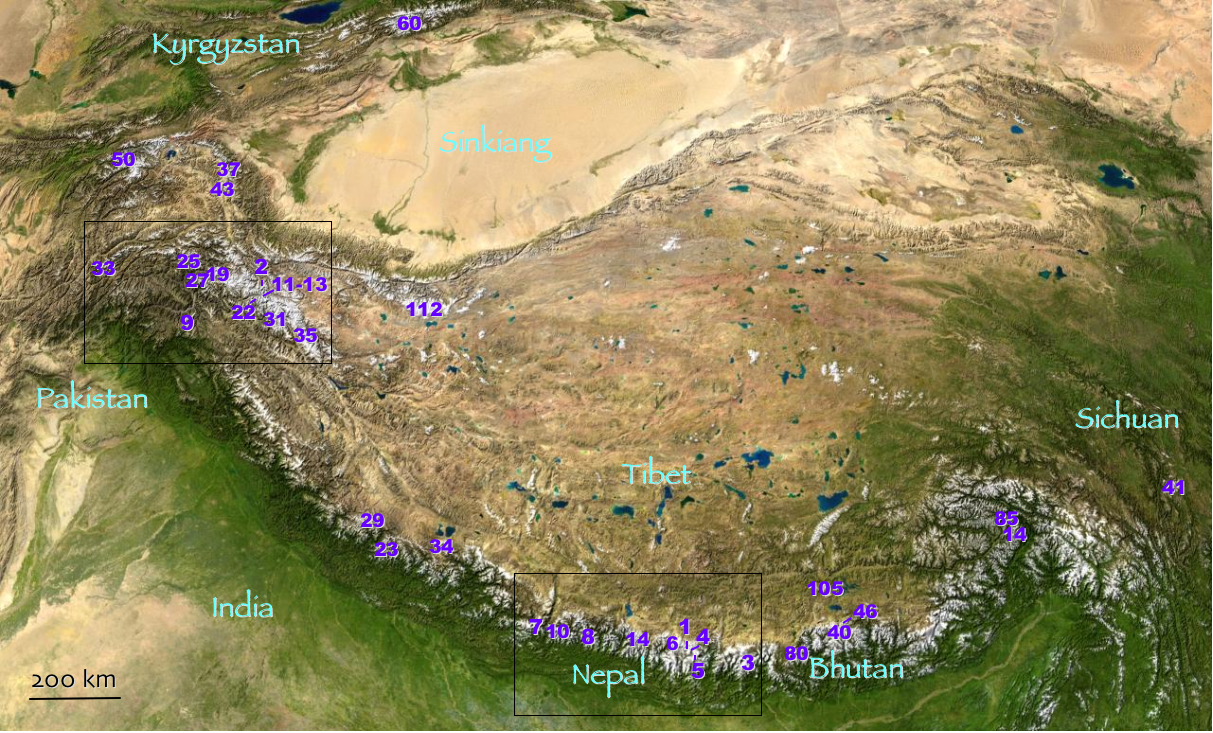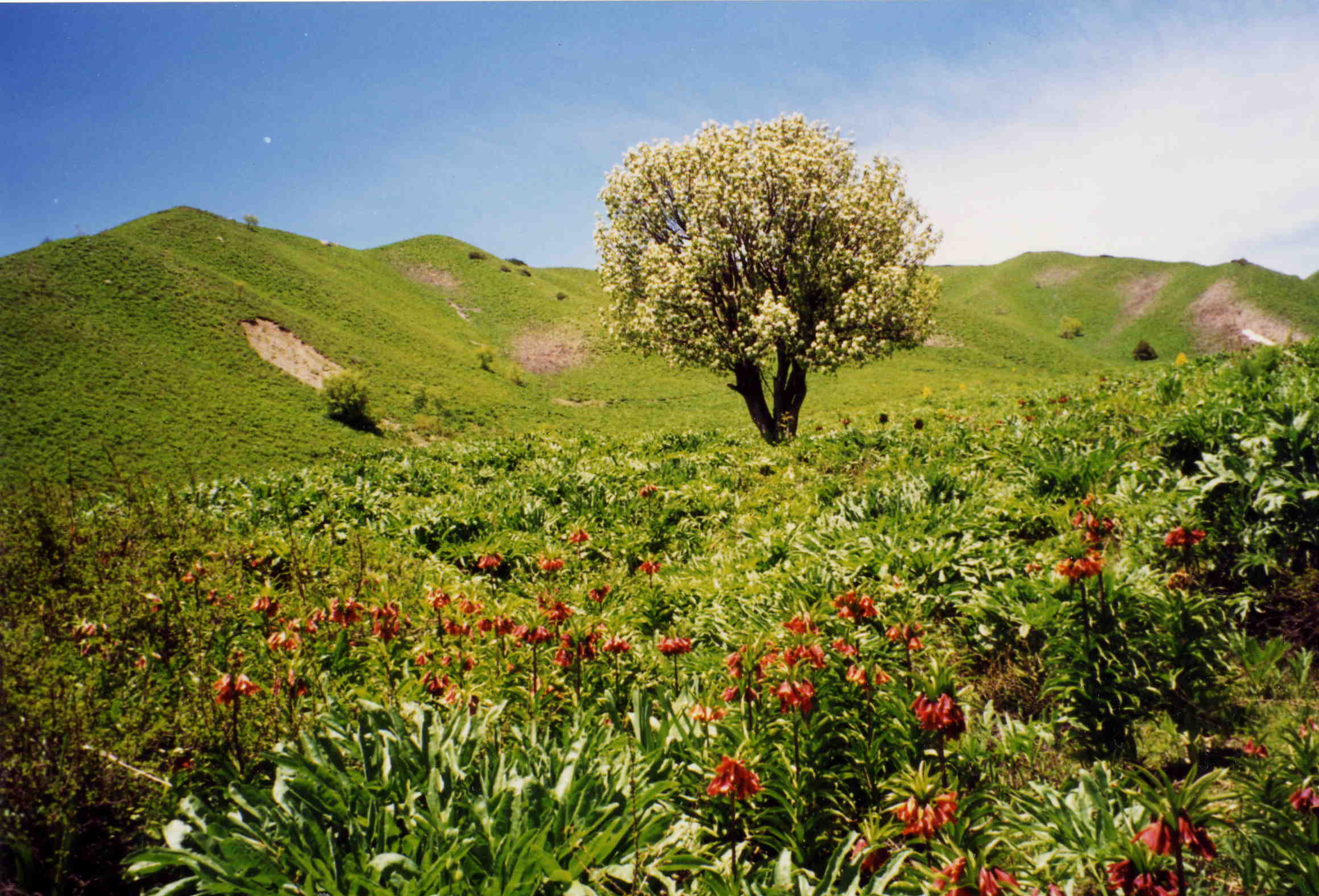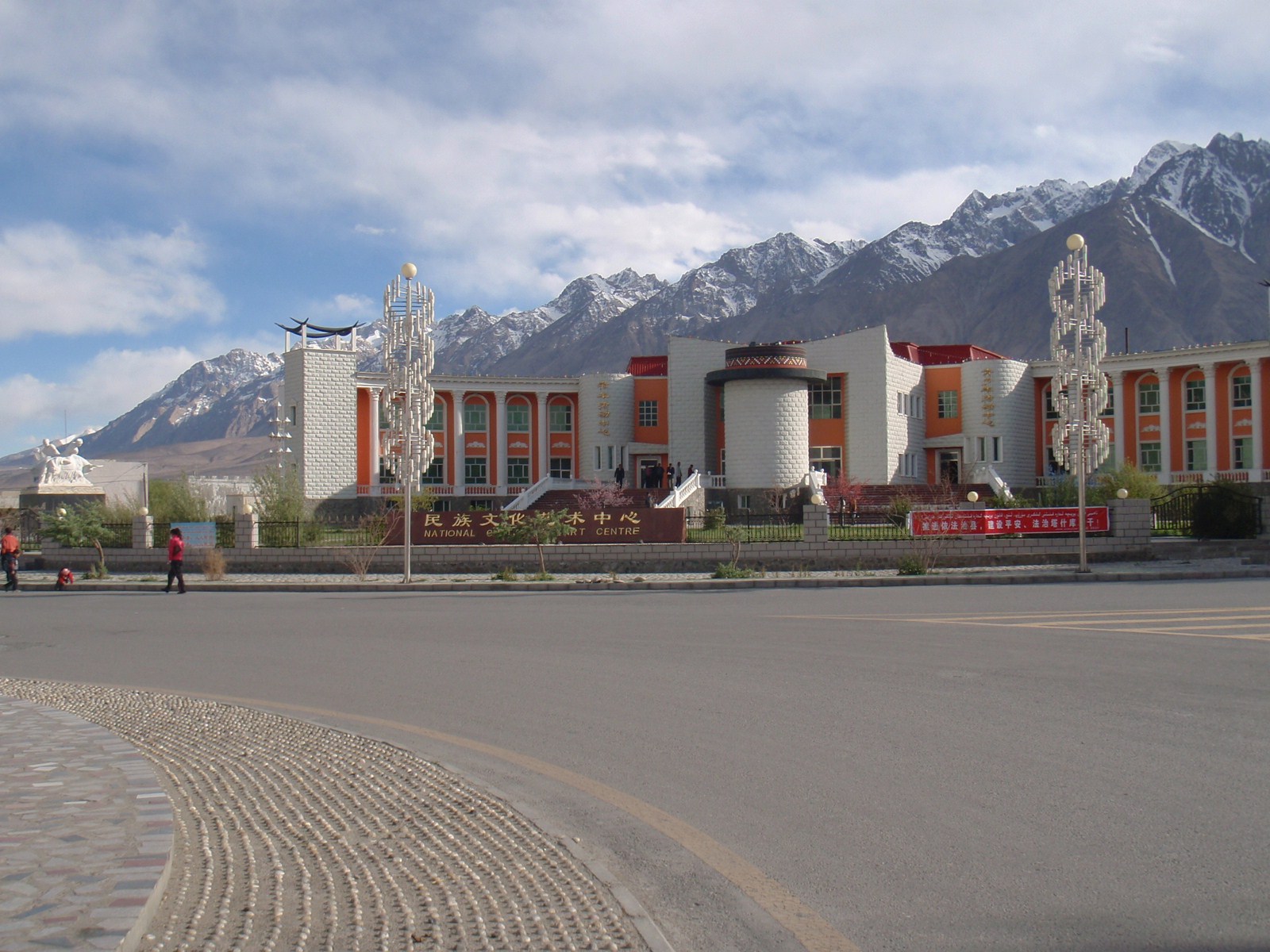|
Karakul (Xinjiang)
The Karakul or Karakuli (, ; ; ; , lit. "black lake"), is a lake located 196 km southwest of Kashgar, Xinjiang. It is located in Akto County, Kizilsu Kirgiz Autonomous Prefecture on the Karakoram Highway, before reaching Tashkurgan, the Khunjerab Pass on the China - Pakistan border and Sost in Pakistan. At an altitude of 3,600 m, it is one of the highest lakes of the Pamir plateau, near the junction of the Pamir, Tian Shan and Kunlun mountain ranges. Surrounded by mountains which remain snow-covered throughout the year, the three highest peaks visible from the lake are the Muztagh Ata (7,546 m), Kongur Tagh (7,649 m) and Kongur Tiube Kongur Tagh, which means "a brown mountain" in Uyghur language, has a significant subpeak known as Kongur Tiube ( 公格尔九别峰 which means in the local language "the mountain with a white cap", also Kongur Tiubie / Jiubie and Kungur Tjube Ta ... (7,530 m). The meltwater from the nearby Muztagh Ata glaciers profoundly influences the ... [...More Info...] [...Related Items...] OR: [Wikipedia] [Google] [Baidu] |
Xinjiang
Xinjiang,; , SASM/GNC romanization, SASM/GNC: Chinese postal romanization, previously romanized as Sinkiang, officially the Xinjiang Uygur Autonomous Region (XUAR), is an Autonomous regions of China, autonomous region of the China, People's Republic of China (PRC), located in the Northwest China, northwest of the country at the crossroads of Central Asia and East Asia. Being the List of Chinese administrative divisions by area, largest province-level division of China by area and the List of the largest country subdivisions by area, 8th-largest country subdivision in the world, Xinjiang spans over and has about 25 million inhabitants. Xinjiang Borders of China, borders the countries of Afghanistan, India, Kazakhstan, Kyrgyzstan, Mongolia, Pakistan, Russia, and Tajikistan. The rugged Karakoram, Kunlun Mountains, Kunlun and Tian Shan mountain ranges occupy much of Xinjiang's borders, as well as its western and southern regions. The Aksai Chin and Trans-Karakoram Tract regions ... [...More Info...] [...Related Items...] OR: [Wikipedia] [Google] [Baidu] |
Pakistan
Pakistan, officially the Islamic Republic of Pakistan, is a country in South Asia. It is the List of countries and dependencies by population, fifth-most populous country, with a population of over 241.5 million, having the Islam by country#Countries, second-largest Muslim population as of 2023. Islamabad is the nation's capital, while Karachi is List of cities in Pakistan by population, its largest city and financial centre. Pakistan is the List of countries and dependencies by area, 33rd-largest country by area. Bounded by the Arabian Sea on the south, the Gulf of Oman on the southwest, and the Sir Creek on the southeast, it shares land borders with India to the east; Afghanistan to the west; Iran to the southwest; and China to the northeast. It shares a maritime border with Oman in the Gulf of Oman, and is separated from Tajikistan in the northwest by Afghanistan's narrow Wakhan Corridor. Pakistan is the site of History of Pakistan, several ancient cultures, including the ... [...More Info...] [...Related Items...] OR: [Wikipedia] [Google] [Baidu] |
Kyrgyz People
The Kyrgyz people (also spelled Kyrghyz, Kirgiz, and Kirghiz; or ) are a Turkic peoples, Turkic ethnic group native to Central Asia. They primarily reside in Kyrgyzstan, Uzbekistan, and China. A Kyrgyz diaspora is also found in Russia, Tajikistan, and Kazakhstan. They speak the Kyrgyz language, which is the official language of Kyrgyzstan. The earliest people known as "Kyrgyz" were the descendants of several Central Asian tribes, first emerging in western Mongolia around 201 BC. Modern Kyrgyz people are descended in part from the Yenisei Kyrgyz that lived in the Yenisey river valley in Siberia. The Kyrgyz people were constituents of the Tiele people, the Göktürks, and the Uyghur Khaganate before establishing the Yenisei Kyrgyz Khaganate in the 9th century, and later a Kyrgyz khanate in the 15th century. Etymology There are several theories on the origin of ethnonym ''Kyrgyz''. It is often said to be derived from the Turkic languages, Turkic word ''kyrk'' ("forty"), ... [...More Info...] [...Related Items...] OR: [Wikipedia] [Google] [Baidu] |
Kongur Tiube
Kongur Tagh, which means "a brown mountain" in Uyghur language, has a significant subpeak known as Kongur Tiube ( 公格尔九别峰 which means in the local language "the mountain with a white cap", also Kongur Tiubie / Jiubie and Kungur Tjube Tagh), ; elevation = . Ranked 46th It is moderately independent, with a topographic prominence of . It was first climbed in 1956. In 2015, Chinese state media reported about a huge body of the Kongur Tiube glacier collapsing causing a 20 km long and one kilometre wide ice rock avalanche. Footnotes See also * Karakoram Highway The Karakoram Highway (, ), also known as the KKH, National Highway 35 (), N-35, and the ChinaPakistan Friendship Highway, is a National Highways of Pakistan, national highway which extends from Hasan Abdal in the Punjab, Pakistan, Punjab p ... * Kongur Tagh References * Ward, Michael. (1983). "The Kongur Massif in Southern Sinkiang." ''The Geographical Journal'', Vol. 149, No. 2 (Jul., 1983), pp. 1 ... [...More Info...] [...Related Items...] OR: [Wikipedia] [Google] [Baidu] |
Kongur Tagh
The Kongur Tagh (meaning 'Brown Mountain' in English) is the highest peak in the Pamir Mountains, and also the highest mountain wholly within the Xinjiang Uyghur Autonomous Region, China. With an elevation of , it is also the highest mountain outside of the Hindu Kush/Karakoram and Himalaya ranges. Geography Kongur Tagh is within a range called the Kongur Shan (.) Kongur Tagh is located just north of Muztagh Ata and visible from Karakul Lake. Some sources use "Kongur Shan" mistakenly to refer to the peak itself. The Kongur Shan range, including Muztagh Ata, is separated by the major Yarkand River valley from the Kunlun Mountains and thus is included in the "Eastern Pamirs". Kongur Tagh is the highest peak in the Pamirs. Due to its remoteness and being hidden by nearby peaks, Kongur was not discovered by Europeans until 1900. However, the building of the Karakoram Highway from Pakistan to China, which runs past nearby Tashkurgan and Karakul Lake, has now made it more accessib ... [...More Info...] [...Related Items...] OR: [Wikipedia] [Google] [Baidu] |
Muztagh Ata
Muztagh Ata (meaning 'Ice Mountain Father' in English), formerly known as Mount Tagharma and Wi-tagh, is the second highest of the mountains which form the northern edge of the Tibetan Plateau, with an elevation of . It is sometimes regarded as being part of the Kunlun Mountains, although physically it is more closely connected to the Pamirs. It is one of the relatively easier 7,000 m peaks in the world to climb, due to its gentle western slope and the comparatively drier weather of Xinjiang, though a thorough acclimatization period and a very strong physical condition are crucial for success. Location Muztagh Ata lies just south of Kongur Tagh, the highest peak of this somewhat isolated range that is separated from the main chain of the Kunlun by the large Yarkand River valley, and thus generally included in the "Eastern Pamirs". Not far to the north and east of this group are the lowlands of the Tarim Basin and the Taklamakan Desert. The Karakoram Highway passes v ... [...More Info...] [...Related Items...] OR: [Wikipedia] [Google] [Baidu] |
Kunlun Mountains
The Kunlun Mountains constitute one of the longest mountain chains in Asia, extending for more than . In the broadest sense, the chain forms the northern edge of the Tibetan Plateau south of the Tarim Basin. Located in Western China, the Kunlun Mountains have been known as the "Forefather of Mountains" in China. The exact definition of the Kunlun Mountains varies over time. Older sources used Kunlun to mean the mountain belt that runs across the center of China, that is, Altyn Tagh along with the Qilian and Qin Mountains. Recent sources have the Kunlun range forming most of the south side of the Tarim Basin and then continuing east, south of the Altyn Tagh. Sima Qian ('' Records of the Grand Historian'', scroll 123) says that Emperor Wu of Han sent men to find the source of the Yellow River and gave the name Kunlun to the mountains at its source. The name seems to have originated as a semi-mythical location in the classical Chinese text '' Classic of Mountains and Seas''. ... [...More Info...] [...Related Items...] OR: [Wikipedia] [Google] [Baidu] |
Tian Shan
The Tian Shan, also known as the Tengri Tagh or Tengir-Too, meaning the "Mountains of God/Heaven", is a large system of mountain ranges in Central Asia. The highest peak is Jengish Chokusu at high and located in Kyrgyzstan. Its lowest point is at the Turpan Depression, which is below sea level. The Tian Shan is sacred in Tengrism. Its second-highest peak is known as Khan Tengri, which can be translated as "Lord of the Spirits". At the 2013 Conference on World Heritage, the eastern portion of Tian Shan in western China's Xinjiang Region was listed as a World Heritage Site. The western portion in Kyrgyzstan, Kazakhstan, and Uzbekistan was then listed in 2016. Geography Tian Shan with the ancient Silk Road The Tian Shan range is located north and west of the Taklamakan Desert and directly north of the Tarim Basin. It straddles the border regions of Kazakhstan, Kyrgyzstan, Uzbekistan and Xinjiang in Northwest China. To the south, it connects with the Pamir Mountains ... [...More Info...] [...Related Items...] OR: [Wikipedia] [Google] [Baidu] |
Sust
The Shahjalal University of Science and Technology, abbreviated as SUST, is a public research university in Sylhet, Bangladesh. Established in 1986, it is one of the leading universities in pioneering research and education in the physical sciences and engineering in the country. It is the 8th oldest university of the country and the first university to adopt American credit system. In 2017, the university had the highest research expenditure among all universities in Bangladesh. Following the success of SUST, twelve more STEM universities have been established in the country by the Government of Bangladesh. History Shahjalal University of Science and Technology was established in 1986. The campus is located in Kumargaon, approximately six kilometers away from the heart of Sylhet City Centre. The university started its academic program with three departments: physics, chemistry, and economics. Renowned scientist and educator Sadruddin Ahmed Chowdhury was the first vice- ... [...More Info...] [...Related Items...] OR: [Wikipedia] [Google] [Baidu] |
Pamir Mountains
The Pamir Mountains are a Mountain range, range of mountains between Central Asia and South Asia. They are located at a junction with other notable mountains, namely the Tian Shan, Karakoram, Kunlun Mountains, Kunlun, Hindu Kush and the Himalayas, Himalaya mountain ranges. They are among the world's highest mountains. Much of the Pamir Mountains lie in the Gorno-Badakhshan region of Tajikistan. Spanning the border parts of four countries, to the south, they border the Hindu Kush mountains along Afghanistan's Wakhan Corridor in Badakhshan Province, Chitral District, Chitral and Gilgit-Baltistan regions of Pakistan. To the north, they join the Tian Shan mountains along the Alay Valley of Kyrgyzstan. To the east, they extend to the range that includes China's Kongur Tagh, in the "Eastern Pamirs", separated by the Yarkand River, Yarkand valley from the Kunlun Mountains. Since the Victorian era, they have been known as the "Roof of the World", presumably a translation from Persian ... [...More Info...] [...Related Items...] OR: [Wikipedia] [Google] [Baidu] |
Khunjerab Pass
Khunjerab Pass (; ; ) is a mountain pass in northern Pakistan that lies at an elevation of above sea level. It is located in the Karakoram and holds a significant strategic position on the northern border of Pakistan, specifically in the Gilgit-Baltistan's Hunza and Nagar Districts. Additionally, it is positioned on the southwestern border of China, within the Xinjiang region. Near Khunjerab Pass, there is another pass known as , which stands at an elevation of and is located at approximately . Etymology The word "خنجراب" in the local Wakhi language means 'waterfall house'. It is derived from two words, "خون"-"Khun" means house and "جراب"-"Jerab" means a creek coming from a spring or a waterfall. Notability The Khunjerab Pass holds several distinctions, including being the highest paved international border crossing globally and serving as the highest point along the Karakoram Highway. The construction of the road across this pass was completed in 19 ... [...More Info...] [...Related Items...] OR: [Wikipedia] [Google] [Baidu] |
Tashkurgan
Tashkurgan, historically known as Sarikol and Shitoucheng, is a town in the far west of China, close to the country's border with Tajikistan. It is seat of Tashkurgan Tajik Autonomous County, in the autonomous region of Xinjiang. Tajiksethnic Pamiris who live in the Pamir Mountains of Xinjiangmake up a little over half of Tashkurgan's population. Tashkurgan was a significant stop on the Silk Road, with roads leading to major centers of trade such as Kashgar. It also served as the capital of a number of ancient and pre-modern kingdoms. Etymology The town is named after a stone fortress to its north; Tashkurgan accordingly means "stone fortress" in the Turkic languages. The official English spelling (per the Chinese government) of the name is ''Taxkorgan'', while ''Tashkorgan'' appears occasionally in literature. The historical Chinese name for the town was ''Shitoucheng'' (), which literally means "stone city" in the context of a fortified city. The town was also historic ... [...More Info...] [...Related Items...] OR: [Wikipedia] [Google] [Baidu] |






